|
|
Post by groundhog on Feb 28, 2013 10:13:07 GMT
Augustus Barry
American Civil War
28th February 1870  Augustus Barry was born in 1840. During the American Civil War her served as a Sergeant-Major in the 16th Infantry Regiment. His Medal of Honor was awarded on 28th February 1870 for “Gallantry in various actions during the rebellion” Barry died on August 3, 1871 and he is buried in Cold Harbor National Cemetery, Virginia |
|
|
|
Post by groundhog on Mar 2, 2013 23:25:26 GMT
Peter O'Brien
Waynesboro, Virginia
2nd March 1865  Born in Dublin in 1842, Peter O’Brien served as a Private in Company A, 1st New York Cavalry during the American Civil War. The Battle of Waynesboro was part of Sheridan’s Expedition to Petersburg. On February 27th Maj-Gen. Philip Sheridan with two cavalry divisions rode from Winchester up the Shenandoah Valley to Staunton. Turning east, the Federals encountered the last remnant of Lt-Gen. Jubal Early’s Valley army at Waynesboro on March 2nd. After a brief stand-off, a Federal attack rolled up Early’s right flank and scattered his small force. More than 1,500 Confederates surrendered. Early and a few of his staff evaded capture. Sheridan crossed the Blue Ridge to Charlottesville and then raided south, destroying the James River Canal locks near Goochland Court House. He joined forces with the Army of the Potomac near Petersburg on March 26th for the opening of the Appomattox Campaign. Peter O’Brien earned a Medal of Honor for the capture of flag and of a Confederate officer with his horse and equipment at Waynesboro. He died in Chicago, Illinois on 30th September 1898 and he is buried Rosehill Cemetery.
|
|
|
|
Post by groundhog on Mar 7, 2013 13:37:46 GMT
Bartlett Laffey
USS Marmora, Yazoo City, Mississippi
5th March 1864 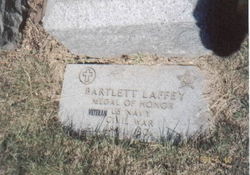 Bartlett Laffey was born in Co. Galway in 1841. He joined the US Navy in Massachusetts in 1862 and was part of the crew of the USS Marmora, a stern wheel gunboat operating on the Mississippi River. Early on Saturday morning 5th March 1864 Confederate troops under Ross and Richardson launched an attack on the Federal picket on the Benton road just outside of Yazoo City, Mississippi. The Union troops in Yazoo City were collected in two redoubts, commanded respectively by Maj. McKee, with the 11th Illinois Infantry, and Lieut.-Col. Peebles, with part of the 8th Louisiana Coloured Infantry. In command in the city was Col. James H. Coates. By 10 am Richardson's troops had entered the city penetrating the Federal lines between McKee and Peebles positions. McKee was called on to surrender several times, but each time refused, even though he was entirely surrounded. Coates men engaged in a house to house battle and street fighting in the city. Reinforcements were brought in from the naval gunboats on the river which landed artillery pieces and their crews to support the army. At 2 p.m. the Confederates in the town and the force surrounding McKee were driven back, withdrawing to Vicksburg on the 6th. Among the sailors landed from the gunboats was Seaman Bartlett Laffey. He was part of the crew of a 12-pound howitzer mounted on a field carriage. Laffey landed with the gun and crew in the middle of a fierce battle and helped work the gun despite enemy rifle fire which cut the gun carriage and rammer. Three of the crew including Laffey were awarded Medals of Honor on 16th April 1864. Bartlett Laffey died in Chelsea, Massachusetts on 22nd March 1901. He is buried in New Calvary Cemetery, Suffolk County, Massachusetts. |
|
|
|
Post by groundhog on Mar 7, 2013 16:47:07 GMT
George Schutt
St. Marks, Florida
5th March 1865  The battlefield as it appears today Despite his name George Schutt was born in Ireland in 1833. He joined the US Navy in New York and was serving in Florida in 1865. He was awarded a Medal of Honor for his action as part of a gun crew at the Battle of Natural Bridge on March 5th-6th 1865. Natural Bridge is where the St. Marks River drops into a sinkhole and flows underground for one-quarter of a mile before reemerging. During the final weeks of the Civil War, a Union flotilla landed at Apalachee Bay planning to capture Fort Ward and march north to Tallahassee. Confederate volunteers from the Tallahassee area many of them old men and young boys - met the Union forces at Natural Bridge and successfully repulsed three major attacks. Coxswain George Schutt was part of the Naval crews of howitzers during the battle. Schutt was awarded the MOH for his efforts in assisting the transport of his gun, and his coolness and determination in courageously remaining at his post under heavy fire. Schutt’s date of death and burial place are unknown. www.exploresouthernhistory.com/nbindex.html
|
|
|
|
Post by groundhog on Mar 13, 2013 18:08:40 GMT
James Fegan
Plum Creek, Kansas
13th March 1868  James Fegan was born in Athlone in 1827 and served as a policeman for a short time before emigrating to the US, where he joined the Army. He enlisted in the 2nd Infantry Regiment in New York on 29th October 1851. He rose to the rank of Sergeant before the Civil War, during which conflict he was wounded several times. At some stage he was discharged but re-enlisted in the 3rd Infantry on 31st March 1864. In March 1868 Sgt Fegan was in charge of an escort on a powder train travelling from Fort Harker to Fort Dodge in Kansas. En route the convoy captured a deserter. While camped at Plum Creek the convoy was attacked by a mob led by a Sergeant John Blake of the 7th Cavalry, who intended to free the prisoner. In the confrontation the mob attempted to set fireto apowder wagon. Fegan drove them off with gunfire, wounding two desperadoes. When he arrived at Fort Dodge on the 13th he was recommended for the Medal of Honor, which he received on October 19th 1868. James Fegan served on in the army, retiring in 1885. He died on June 25th 1886 in Montana and is buried in Custer National Cemetery.
|
|
|
|
Post by groundhog on Mar 13, 2013 22:06:49 GMT
Patrick Kyle
USS Quinnebaug, Port Mahon, Minorca
13th March 1879 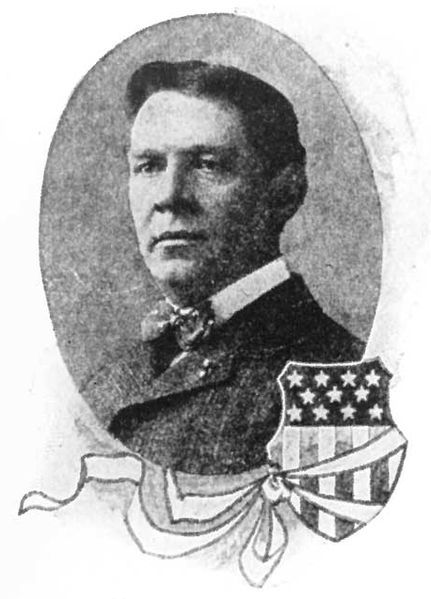 Patrick Kyle was from Sligo, born 4th November 1854. In 1879 he was a Landsman aboard the USS Quinnebaug a recently built corvette which had just started a ten year stint on the Mediterranean station. On 13th March 1879 Kyle rescued from drowning a shipmate at Port Mahon, Minorca and was subsequently awarded the Medal of Honor. Patrick Kyle died on 28th October 1929 in Charlestown, Massachusetts. He is buroed in New Calvary Cemetery. |
|
|
|
Post by groundhog on Mar 19, 2013 10:47:05 GMT
Jeremiah Murphy
Powder River, Montana
17th March 1876 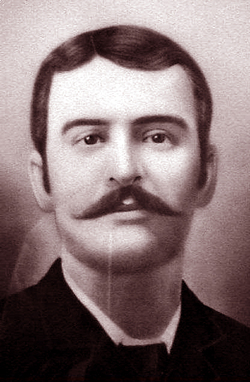 Jeremiah Murphy was born in Co. Cork on 2nd February 1858. He won a Medal of Honor serving with the 3rd Cavalry Regiment at the Battle of Powder River, Montana on 17th March 1876. The battle was badly planned and executed and ultimately led to the dismissal of the man who commanded the troops, Col Joseph Reynolds. The Sioux Indians had been granted exclusive rights to the Black Hills by treaty in 1868. However gold was discovered in the area in 1874 and the US government decided to forcibly buy the land from the Indians. An ultimatum was issued to all of the local tribes to report to the reservations in the area by January 31st 1876. When the deadline had passed with many tribes having refused to comply, orders were issued to commence operations against the Indians. General George Crook left Fort Fetterman with almost 900 mne on March 1st to track down Indian encampments on the Powder, Tongue and Rosebud Rivers. The weather was appalling, with the troops marching through blizzard conditions on half rations. Finally on March 16th two Sioux scouts were spotted. Col Reynolds was sent with 320 men in pursuit of these two scouts who led them to a Cheyenne village on the Powder River. Reynolds plan was to split his force into three with one detachment occupyng the hills to the north-west of the village while the other two attacked from the south and west. The two companies of cavalry attacking from the south were further split with one company tasked with capturing the Indian horses and the other with attacking the village. Due to the terrain and the weather only the southern attack went in and Capt Egan’s company of the 3rd Cavalry attacked the village on its own with 54 men. Consequently all of the Indians escaped bar one man killed. Three cavalrymen were killed in the attack and six wounded. It was in attempting to save one of the wounded that Jeremiah Murphy earned his Medal of Honor, his citation reading “Being the only member of his picket not disabled, he attempted to save a wounded comrade.” His medal was issued on 16th October 1877. Jeremiah Murphy died on May 12th 1932 in Washington DC and is buried in Mount Olivet Cemetery.
|
|
|
|
Post by groundhog on Mar 30, 2013 19:11:15 GMT
Thomas Prendergast
Philippine Islands
25th March 1899  Thomas Prendergast was born in Waterford on 2nd April 1871. He joined the United States Marine Corps in Massachusetts in 1893 and served in the Philippine-American War. The war resulted from the US annexation of the islands after the war with Spain. Prendergast was involved in the battle to clear Philippine rebels out of the area of Manila. His Medal of Honor citation covers several dates beginning on March 25th 1899. His medal was issued on 19th July 1901. Prendergast died in Philadelphia on 26th April 1913 where he is buried in Greenwood Cemetery.
|
|
|
|
Post by groundhog on Mar 31, 2013 0:50:32 GMT
Thomas Cahey
USS Petrel, Manila Bay
31st March 1901 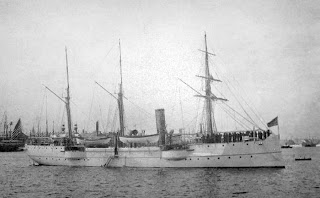 On the morning of 31st March 1901 the USS Petrel was in Manila Bay, Philippine Islands when a fire broke out in the sail locker which was located next to the ship’s magazine. Some men were detailed to clear ammunition out of the magazine while another group, led by the ship’s Captain Jesse Roper, fought the fire which was producing acrid smoke and fumes. To add to the men’s difficulties the sail locker was pitch dark as the ship’s generator was off line. With the fumes threatening to overcome his men Roper ordered the locker to be evacuated but one man was left behind. Roper led four men back to rescue the missing man but the four were quickly overcome by fumes. Two of them plus the missing were rescued by another member of the ship’s crew who tied a rope around his waist and was pulled unconcious from the locker room clinging to another unconcious man. Another rescue crew of three men entered the locker room and located the missing men. All recovered except for Roper who died as a result of the fumes in the locker room.  Amongst those in the last rescue crew was Seaman Thomas Cahey, born in Belfast on 13th April 1870. For his courage in rescuing the men in the locker room he was one of three men awarded a Medal of Honor on 22nd March 1902. He became a Chief Gunners Mate before leaving the Navy and he died on 5th January 1935. Heis buried in Arlington National Cemetery. |
|
|
|
Post by groundhog on Apr 1, 2013 16:16:32 GMT
Five Forks, Virginia
1st April 1865  Ulysses S. Grant is still busy trying to force the Army of Northern Virginia out of Petersburg. The Confederates are at this stage left with a single supply line, the South Side Railroad. Grant ordered Phil Sheridan to advance his cavalry on this railroad by way of a crucial road junction known as Five Forks. In turn Lee ordered Maj-Gen George Pickett’s division along with cavalry support to hold Five Forks. Once the Union Cavalry made contact with the Confederates, Sheridan received infantry support from Maj-Gen Gouverneur K. Warren's Fifth Corps. There was a brief delaying action south of Five Forks at Dinwiddie Courthouse on March 31st after which Pickett withdrew his command to Five Forks where he dug in. On April 1st Sheridan’s cavalry pinned the Confederates down while Warren’s Fifth Corps assaulted the Confederate left and rear, turning their position and taking scores of prisoners. Strangely Pickett was absent from his command at this crucial time, reportedly attending a shad bake when the fighting began. Ultimately the battle ended in a resounding Union victory that led to te fall of Petersburg and Richmond. Map courtesy of www.civilwar.orgwww.petersburgsiege.org/five.htm Thomas Murphy  Thomas was born in Ireland in 1833. In 1865 he was a First Sergeant in Company G, 146th New York Infantry. His Medal of Honor was issued on 10th May 1865 for the capture of a Confederate flag at Five Forks. Murphy died on 2nd December 1901 and is buried in Pound Ridge Cemetery, Westchester, New York Joseph Stewart Joseph Stewart is a mystery man. He was born in Ireland on an unknown date, served as a Private, Company G, 1st Maryland Infantry and like Thomas Murphy was awarded a Medal of Honor for the capture of a Confederate flag . His medal was issued on 27th April 1865. Stewart’s date of death and burial location ae unknown.
|
|
|
|
Post by groundhog on Apr 2, 2013 22:38:40 GMT
Petersburg, Virginia
2nd April 1865 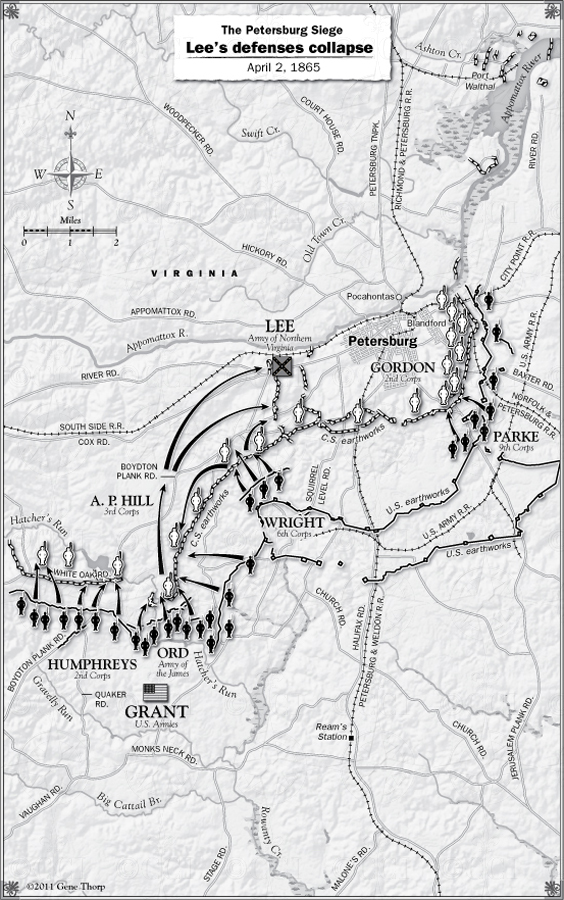 The Fall of Petersburg or the Third Battle of Petersburg took place on 2nd April 1865, following immediately on from the Battle of Five Forks. No less than eight men from Ireland won Medals of Honor on the day. Most of the fighting took place to the south and west of Petersburg . At Fort Mahone the Union IX Corps under Gen Parke assaulted the fort at aboutb 4.30am and drove the Confederate defenders from their trenches. Parke called for reinforcements and drove back a counter attack. Other heavy fighting took place on the Boydton Line where the VI Corps broke through after twenty minutes. The Corps commander, Gen Horatio Wright ordered his Corps to turn left to roll up the Confederate defences. The gaps caused by Confederate defenders having to re organise to meet the threat from their flank allowed Gibbon’s XXIV Corps to break through the Boydton Line. Gibbon headed north for the town of Petersburg. In his way however were two Confederate strongpoints-Fort Gregg and Fort Whitworth. The Confederates made a stand here to allow time for reinforcements to advance from Richmond. Despite heavy cannon fire from Whitworth, XXIV Corps took Fort Gregg and then Fort Whitworth. Here they stopped, unable to advance further. Three Union Corps were now either under attack from Confederate forces or used up from heavy fighting. Only one Corps remained uncommitted, II Corps under Gen Andrew Humphreys. Humphreys indeed didn’t have command of his full Corps, Miles’ Division having been sent off to reinforce another Corps. Nevertheless Humphrey’s attacked with one division the Confederate Corps manning the line Hatcher's Run to White Oak Road. This Corps was Gen AP Hill's Third Corps, now commanded by Gen Heth because Hill had been shot dead by Union stragglers of VI Coprs on the Boydton Line attack. Heth fell back as Humphreys advanced. Simultaneously Miles Division rejoined II Corps and Humphreys received orders to braek off his attack and advance on Petersburg. Leaving Miles Division in pursuit of Heth, Humphreys obeyed orders. Miles pushed Heth’s Corps back to Sutherland's Station, where four Confederate Brigades stood to fight. A short savage battle was fought here in which a thousand men died. Two of his attacks having failed, Miles sent for reinforcements. Gen Humphreys was sent back to his assistance and the Confederates began to retreat about 3 pm. Lee ordered a general retreat from Petersburg to the west, hoping to make his way to North Carolina. Grant took Petersburg that evening and the following day occupied the Confederate Capital at Richmond. William Blackwood  William Robert Douglas Blackwood was born on 12th May 1838 in Hollywood, Co. Down. His family moved to the US in 1850 and William graduated from the University of Pennsylvania medical school in 1862. He joined Army serving first as an Assistant Surgeon in the 149th Pennsylvania Volunteer Infantry until April 28th 1863. He was promoted to Surgeon in the 48th Pennsylvania Volunteer Infantry. His united served for almost a year at Petersburg before the final assault. During the fighting at Fort Mahone on 2nd April Blackwood exposed himself to enemy fire on two occasions to aid two mortally wounded officers, Major Peckham and Colonel Gowen. He was awarded the Medal of Honor for these acts. Having been wounded in action on four occasions, Blackwood left the Army in July 1865. He did however occasionally return to active duty, claiming to have served in the Indian, Franco-Prussian, Spanish-American, and Mexican-Border wars. He married in 1874, and had four children. His medal was issued on 21st July 1897. Blackwood died in Philadelphia on 26th April 1922 and was buried in Chelten Hills Cemetery. His grave was unmarked until 2006. John Havron John Havron was born in Ireland on 23rd December 1843. He joined the army in Providence, Rhode Island, serving as a Sergeant in Company G, 1st Rhode Island Light Artillery. 1st Rhode Island Light Artillery was in II Corp and Havron one of a detachment of 20 artillerymen who voluntarily accompanied an infantry assaulting party and who turned upon the enemy the guns captured in the assault. For this he was awarded the Medal of Honor on 16th June 1866. He died in New Orleans on 28th October 1910. Patrick Highland Highland was born in Tipperary on an unknown date. He joined the army in Chicago, serving as a Corporal in Company D, 23d Illinois Infantry. He displayed “Conspicuous gallantry as color bearer in the assault on Fort Gregg” with XXIV Corps and was awarded a Medal of Honor on 12th May 1865. Thomas McGraw Thomas McGraw also served in 23d Illinois Infantry at Fort Gregg, as a Sergeant in Company B. He was born in Ireland in 1834 and died in Lacrosse, Kansas on 1st January 1899. At Fort Gregg he was noted as having been “One of the three soldiers most conspicuous for gallantry in the final assault” and was awarded the Medal of Honor on 12th May 1865. John Kane Corporal John Kane served at Fort Gregg in Company K, 100th New York Infantry. Like Havron he displayed “Gallantry as color bearer in the assault on Fort Gregg” and was awarded the Medal of Honor on 12th May 1865. Richard Mangam 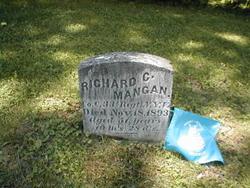 Mangam was born in Ireland on 21st December 1841. He served as a Private in Company H, 148th New York Infantry at Hatchers Run where he captured the flag of the 8th Mississippi Infantry. Mangam died on September 21st 1888 in Decatur, New York and is buried in Maple Grove Cemetery where his headstone displays what was probably his correct surname, Mangan. George McKee  George McKee was a Color Sergeant in Company D, 89th New York Infantry in the assault on Fort Gregg. He was awarded a Medal of Honor on 12th May 1865 for “Gallantry as color bearer. “ McKee was born in Co. Tyrone in 1845. He died in Los Angeles, California on 8th July 1892 and is buried in Los Angeles National Cemetery Richard Welch Welch was born in Ireland in 1828. He was a Corporal in Company E, 37th Massachusetts Infantry at Petersburg where he captured a flag and was awarded with the Medal of Honor on 10th May 1865. 37th Massachusetts fought on the Boydton Line with VI Corps. He died in Williamstown, Massachusetts on 13th March 1894 and is buried in Eastlawn Cemetery. |
|
|
|
Post by groundhog on Apr 3, 2013 21:02:36 GMT
Fort Hindman, Arkansas
9th - 1th January 1863 Modern map of the area. The star shape in the river marks the site of the fort on the 1863 shoreline, now underwater Three Irish crewmen of the USS Louisville were awarded Medals of Honor under General Order No 11, dated 3rd April 1863. Unfortunately, as sometimes happens, the GO doesn’t specify the action for which the medals were awarded. However it does specify that the three were crewmen on 9 inch guns. The USS Louisville was equipped with these guns in September 1862, so the most likely action between September 1862 and April 1863 for which the crew received their awards was the attack on Fort Hindman, Arkansas 9th-11th January 1863. In addition the only other crewman of the ship to receive the MOH was an American, William Talbott, who was awarded his medal in 1865 for actions at Fort Hindman. The capture of Fort Hindman was a sideshow to ongoing operations against the Confederate defences of Vicksburg, Mississippi. Fort Hindman was a Confederate earth fort built at Arkansas Post on the confluence of the Arkansas and Mississippi rivers. It was manned by 5,000 Texas Cavalrymen and Arkansas Infantry. The Union forces were commanded on land by Maj-Gen John McClernand and the Naval forces by Admiral David Porter. Maj-Gen Bill Sherman’s Corps was also taken under command by McClernand giving the Union forces a 6 to 1 numerical advantage. Sherman’s Corps landed three miles below Fort Hindman on the afternoon of the 9th January and drove the outlying defences back to the firt. On the 10th the army took all day moving into position to assault the fort, held up by the problems of moving large bodies of men through swamps. Meanwhile the naval element, including the USS Louisville, spent the day bombarding the fort, knocking out artillery pieces. The fighting on the 11th began at 1 pm (the Union army kept very civilised hours at this stage of the war it seems). The ships once again bombarded the fort while the soldiers advanced. By 4.30pm the fort surrendered. The three Irish sailors who were awarded Medals of Honor after the battle were; Timothy Sullivan  Born in 1835, joined the Navy in New York. He was a Coxswain in 1863. His Citation says he “ Served on board the U.S.S. Louisville during various actions of that vessel. During the engagements of the Louisville, Sullivan served as first captain of a 9_inch gun and throughout his period of service was "especially commended for his attention to duty, bravery, and coolness in action." Sullivan died in Los Angeles on 6th October 1910 and is buried in Los Angeles National Cemetery. Charles Bradley Born in 1838, joined the Navy in New York. He was a Boatswain's Mate and his Medal Citation reads “Served on board the U.S.S. Louisville. Carrying out his duties through the thick of battle and acting as captain of a 9-inch gun, Bradley consistently showed, Attention to duty, bravery, and coolness in action against the enemy” Bradley’s date and place of death are unknown. James Byrnes Like Bradley, Byrnes was born in 1838, joined the Navy in New York. He was a Boatswain's Mate and his Medal Citation reads “ Carrying out his duties through the thick of battle and acting as captain of a 9-inch gun, Brynes consistently showed Attention to duty, bravery, and coolness in action against the enemy.” Date and place of death are unknown. |
|
|
|
Post by groundhog on Apr 3, 2013 21:26:27 GMT
Daniel Harrington
Brunswick, Georgia
11th March 1862 Daniel Harrington was a Landsman in the US Navy when he earned his Medal of Honor on 11th March 1862. Harrington was part of the crew of USS Pocahontas on a shore mission near Brunswick, Georgia to procure meat for the ship's crew. As the shore party was returning to the beach, they were fired on from ambush and several men were killed or wounded. Cool and courageous throughout this action, Landsman Harrington rendered gallant service against the enemy and in administering to the casualties. Harrington’s birth year is 1849 which would make him about 13 at the time, meaning that he is one of the youngest recipients of the Medal of Honor. His medal was awarded on 3rd April 1863, being actually presented to him at sea in June of that year. His date and place of death are unknown. |
|
|
|
Post by groundhog on Apr 7, 2013 1:03:06 GMT
Thomas Riley
Fort Blakely, Alabama
4th April 1865 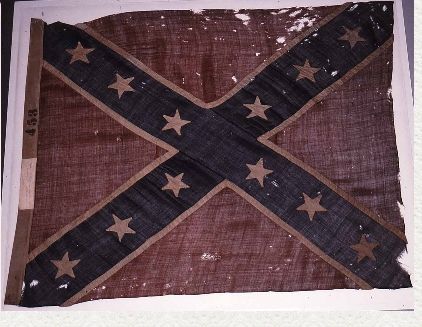 Riley was born in Ireland. In the US his recorded home was New Orleans, Louisiana and during the American Civil War he served in with Company D, 1st Louisiana Cavalry. Despite the unit name they fought for the Union and on 4th April 1865 at Fort Blakely, Alabama, Riley captured the flag of the 6th Alabama Cavalry for which he received the Medal of Honor on 8th June 1865. Thomas Riley disappeared from history and his death and burial place are unknown. The flag tha he captured is preserved by the State of Alabama although their records state that the flag was captured on March 25th 1865 during an engagement which took place between Canoe Creek, Alabama and the Escambia River by Private Thomas Riley, Co. D, 1st Louisiana Cavalry. The flag was subsequently forwarded to the U.S. War Department where it was assigned Capture Number 453. The flag and its staff were returned to the State of Alabama effective April 26th, 1905. The staff, which had been separated from the flag, was located and positively identified in July, 1998.
|
|
|
|
Post by groundhog on Apr 7, 2013 14:36:09 GMT
Sailor’s Creek, Virginia
6th April 1865  When we left the Confederate army a couple of days ago it was withdrawing west from Petersburg. The Union Army is hot pursuit. On the morning of the 6th April II Corps caught up with the retreating Confederates at Holt’s Corner. Durng the pursuit Sheridan’s Cavalry had been riding parallel to the line of retreat, launching raids on the Confederate column. Two Confederate Corps halted and turned to fight the Federal troops. As they did so a gap opened between their positions and the rest of the Confederate army through which Gen George Custer poured his cavalrymen. Almost simultaneously, the Union VI Corps joined the fray. Two of Wright’s divisions deployed at Hillsman’s Farm with artillery support in the mid-afternoon. After a short artillery bombardment one Union infantry division advanced across Little Sailor’s Creek. Advancing on the Confederate lines they were driven back by a counterattack which was only halted by Union artillery firing canister shot. The second Union division came up in support and after another short fight the Confederate troops began to surrender. At Marshall’s Cross roads the Union Cavalry broke another Confederate Corps. These men also began to surrender. Geneal Robert Lee watched the fighting from a distant hill and saw almost one-quarter of his army surrender. Three Irish-born soldiers won Medals of Honor on the day; George Ford Ford was born in Ireland in 1844.In 1865 he was a First Lieutenant in Company E, 88th New York Infantry. He was awarded a Medal of Honor on 10th May 1865 for the capture of a flag. George died in New York on 29th November 1883. He is buried in First Calvary Cemetery, Queens. James Gribben Born in Ireland in April 1839, Gribben served as a Lieutenant in Company C, 2nd New York Cavalry. At Sailors Creek he captured the flag of the 12th Virginia Infantry and was awarded a Medal of Honor on 3rd May 1865. He died in Brooklyn on 6th August 1878 and is buried in Green Wood Cemetery. John Keough Corporal John Keough was from Tipperary and he was born in 1835. During the Civil War he served in Company E, 67th Pennsylvania Infantry. He was awarded a Medal of Honor on 3rd May 1865 for capturing the battle flag of 50th Georgia Infantry at Sailor’s Creek. Keough’sdate of death and burial place are unknown.
|
|